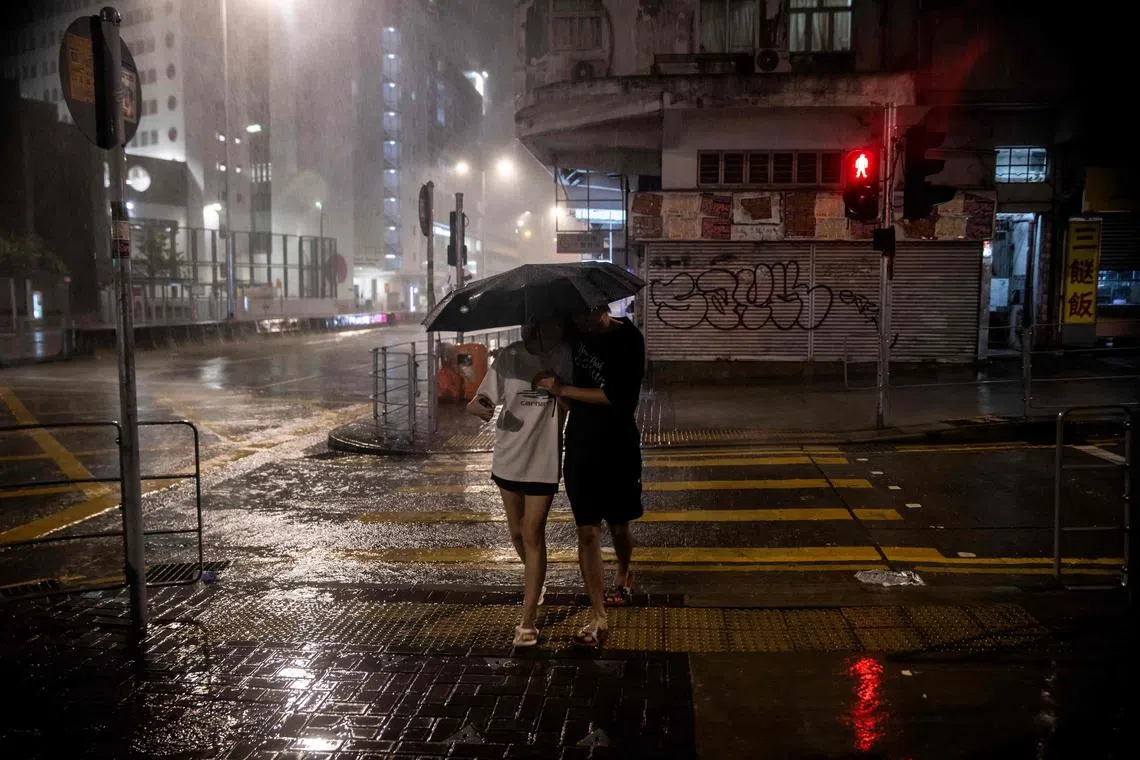Typhoon Saola weakens but still a threat in southern China
Sign up now: Get insights on Asia's fast-moving developments

Over 880,000 people were evacuated across two Chinese provinces and trees were uprooted around the rain-battered streets of Hong Kong.
PHOTO: AFP
Follow topic:
HONG KONG – Typhoon Saola swept across southern China on Saturday
Tens of millions of people in the densely populated coastal areas of southern China sheltered indoors on Friday ahead of the storm.
Saola triggered the highest threat level in Hong Kong on Friday evening – which had been issued only 16 times since World War II.
It was downgraded before dawn on Saturday after the typhoon passed the city, with no reported casualties, and tracked towards coastal areas of mainland China.
But the authorities warned people to remain on alert, with strong winds and storm surges still a threat.
“Gale force winds are still affecting some places... precautions should not yet be relaxed,” said the city’s weather observatory at 8am.
Saola was still packing sustained winds of 145kmh at its centre, creating a storm surge that caused rough swells around Hong Kong’s waterfront areas.
The last time Hong Kong issued a T10 warning was in 2018, when Typhoon Mangkhut slammed into the city, shredding trees and unleashing floods, and leaving more than 300 people injured.
But by Saturday morning, the damage from Saola in Hong Kong looked to be far less than that from Mangkhut.
AFP journalists in the city reported fallen trees, broken windows and solar panels pulled off rooftops.

Tens of millions of people across Hong Kong, Shenzhen and other southern Chinese mega cities were braced for the menace of a cyclone rated as a super typhoon.
PHOTO: AFP
By late afternoon, Hong Kong’s airport, businesses and public transport began slowly resuming operations, while street cleaners cleared debris and uprooted trees that Saola left in its wake.
The Hong Kong Observatory lowered its storm warning to T3 from T10.
Overnight, Saola made landfall in the coastal area of Zhuhai in neighbouring Guangdong province, and was expected to weaken as it moves along the southern coastline.
China’s national weather office on Friday warned Saola “may become the strongest typhoon to make landfall in the Pearl River Delta since 1949”, referring to a low-lying region that includes Hong Kong, Macau and much of Guangdong province.
The authorities evacuated more than 780,000 people from high-risk areas, while eastern Fujian province saw more than 100,000 moved to safer ground.
Hundreds of flights were cancelled, businesses closed, and transport in and out of the affected areas had been halted.
More intense typhoons
Southern China is frequently hit in summer and autumn by typhoons that form in the warm oceans east of the Philippines and then travel west.
Climate change has increased the intensity of tropical storms, with more rain and stronger gusts leading to flash floods and coastal damage, experts say.
In Hong Kong, the authorities received at least seven confirmed cases of flooding, as well as nearly 40 reports of downed trees. The city’s hospital authority reported seven people seeking medical treatment during Saola.
Businesses taped up their glass displays and windows, while high-rise buildings swayed under the whipping gusts.
In eastern Heng Fa Chuen – a coastal residential area and the site of devastation during 2018’s Typhoon Mangkhut – officers in orange vests urged storm-watchers to go home, as trees leaned sideways from the heavy gusts.
In the low-lying fishing village of Lei Yue Mun, which is prone to flooding, water seeped into shops, prompting residents to set up sandbags and board up doors.
“I hope we can save the tools needed for our business, like the fridge. We elevated them so the water wouldn’t damage the (electronics),” a restaurant operator surnamed Lee told a local TV station.
Another storm, meanwhile, is headed for Taiwan and eastern China, with Taipei issuing a land warning on Saturday for the approach of Typhoon Haikui. AFP, BLOOMBERG

